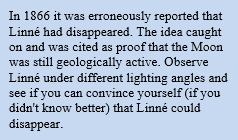The week of January 1 – 7 takes us from Day 14, full moon, to Day 21. This week we will highlight the craters Dionysius and Linné.
 Linné: [NE/G11; L=12°E] Now that we are at full Moon, let’s revisit Linné (which you may have observed on Day 6). The light material that surrounds Linné will be very bright tonight. This small 1.5-mile crater has now expanded into about a 6-mile white spot, and because its appearance changes so much with different angles of illumination, this was once taken as evidence that the Moon was not a totally dead place.
Linné: [NE/G11; L=12°E] Now that we are at full Moon, let’s revisit Linné (which you may have observed on Day 6). The light material that surrounds Linné will be very bright tonight. This small 1.5-mile crater has now expanded into about a 6-mile white spot, and because its appearance changes so much with different angles of illumination, this was once taken as evidence that the Moon was not a totally dead place.
OF ADDITIONAL INTEREST IN SPACE THE WEEK OF JANUARY 1-7:
Monday night’s full moon will be a “SuperMoon” (technically the full moon will occur at 9:25 PM EST). Because the orbit of the Moon around the Earth is elliptical1, a few times a year the full Moon will coincide with its closest perigee2. As a result, it will appear 14% larger and 30% brighter. Find a clear view of the eastern horizon and be in place while the Moon is rising, rather than later when it might be technically closer to the earth but will appear smaller. When the Moon just clears the horizon, the standard illusion that the Moon is bigger will be combined with the fact that it really is bigger–a double whammy that can sometimes be a captivating sight!
1 Kepler’s discovery of the three laws of planetary motion was a major step toward freeing us from the shackles imposed for centuries by Aristotle, Ptolemy, and the Church–all of whom insisted that planets must move in perfect circles.
2 The Moon will come to perigee once a month, but the perigee distance can vary by up to 8,700 miles, so having a full moon coincide with its closest perigee is something that’s worth paying a little attention to. The term “SuperMoon” was actually coined by the astrologer Richard Nolle in 1979 to describe either a full moon or a new moon which coincides with perigee. However, the astronomical community prefers the official but cumbersome term “perigee-syzygy” (probably out of an understandable reluctance to admit that, once in awhile, astrologers could have a point)–but “SuperMoon” is so much easier to say!
======================
It is highly recommended that you get a copy of Sky and Telescope’s Field Map of the Moon, the very finest Moon map available for use at the telescope. It is available for $10.95 at www.skyandtelescope.com and on Amazon. All features mentioned in this blog will be keyed to the grid on the Field Map and will look like this: Plato: [NW/D9]
Credits:
Courtesy of Gray Photography of Corpus Christi, Texas
Lunar photos: NASA / USGS / BMDO / LROC / ASU / DLR / LOLA / Moon Globe. Used by permission
- Rupes Cauchy: A Best Known Fault on the Moon - July 22, 2024
- Moon Crater Schickard – Crater Floor has Stripes - July 15, 2024
- Moon Craters Langrenus and Vandelinus - July 8, 2024